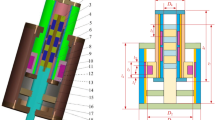Abstract
The structure and principle of a new type of a diphase opposition giant magnetostrictive self-sensing actuator is introduced. A bridge analysis model based on variable inductance is established. Dynamic balance separation technology for the giant magnetostrictive self-sensing actuator comes true by the least means square (LMS) self-adapting algorithm. The scheme design of one important part of the circuit with the real-time separation circuit of the dynamic balance signal based on a digital signal processor is obtained. The part of the signal separated circuit is designed, which includes logarithmicantilog practical multiplication circuit, amplifying circuit, filter circuits, and amplifier circuit. Based on the embedded system simulation software—PROTUES, the simulation effect of the circuit that separates the sensing signal from the mixed signals is obvious, which indicates that the circuit can rapidly and stably work. Moreover, the structure is simple, reliable, and meets the practical requirement.
Similar content being viewed by others
References
Jenner A G, GreenoughR D, Wilkinson A J, Parvinmher A. Performance of magnetostrictive rare earth iron compounds for device. IEEE Transactions on Magnetics, 1990, 26(5): 2589–2591
Tan X B, John S B. Modeling and control of a magnetostrictive actuator. Automatica, 2004, 40(9): 1469–1480
Ben H S, Martin L. Self-sensing applications for electromagnetic actuators. Sensors and Actuators A: Physical, 2004, 116(2): 345–351
Tzou H S, Anderson G L, Natori M C. Active Structure, Device, and Systems: Chapter authored by Gacia E and Jones L D. Singapore: World Science Publishing Company, 1997
Hall D L. Dynamics and vibrations of magnetostrictive transducer. PhD Dissertation, Ames: Iowa State University, 1994, 56–78
John P, Alison B F. Development and analysis of a self-sensing magnetostrictive actuator design. In: Proceedings of SPIE, Smart Structures and Intelligent Systems, Vol 1917, 1993, 952–961
Vipperman J S. Adaptive piezoelectric sensorial actuators for active structural acoustic control. PhD Dissertation, Durham: Duke University, 1997, 67–86
Wong K K, Cheng R S K, Letaief K B, Murch R D. Adaptive antennas at the mobile and base stations in an OFDM/TDMA system. IEEE Transactions on Communications, 2001, 49(1): 195–206
Julie E G. Modified LMS algorithms for speech processing with an adaptive noise cancelle. IEEE Transactions on Speech and Audio Processing, 1998, 6(4): 338–351
Widrow B, Duvall K, Gooch R, Newman W. Signal cancellation phenomena in adaptive antennas: causes and cures. IEEE Transactions on Antennas and Propagation, 1982, 30(3): 469–478
Gorriz J M, Ramirez J, Cruces-Alvarez S, Puntonet C G, Lang E W, Erdogmus D. A novel LMS algorithm applied to adaptive noise cancellation. IEEE Signal Processing Letters, 2009, 16(1): 34–37
Author information
Authors and Affiliations
Corresponding author
Rights and permissions
About this article
Cite this article
Wang, X., Ya, Q., Wang, D. et al. Signal separation technology for diphase opposition giant magnetostrictive self-sensing actuator. Front. Mech. Eng. China 5, 176–183 (2010). https://doi.org/10.1007/s11465-010-0001-5
Received:
Accepted:
Published:
Issue Date:
DOI: https://doi.org/10.1007/s11465-010-0001-5



